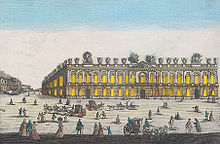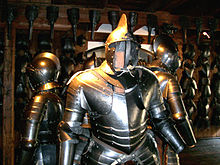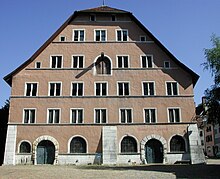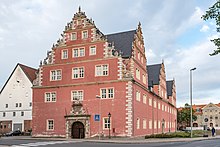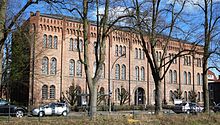Armory
An armory is a building in which weapons and military equipment were stored and repaired. Today, arsenals fulfill the original function of the armory; only in Switzerland is the term armory still used in its true sense.
The term arsenal is also used for the buildings of fire brigades , occasionally also for historical buildings in which hunting gear or other equipment was stored.
Designations
Like other devices, guns used to be called stuff . In the late Middle Ages and early modern times, the designations were armory , armamentarium , (also used for other instruments) Armory and Arsenal often used interchangeably, the term Arsenal prevailed until the 17th century.
The manager as well as those responsible for the armory were referred to as the witness captain or witness master. The kit man was in charge of the weapons.
Historical meaning
Armories were utility buildings that had a symbolic and representative purpose in addition to the military one. These buildings were often constructed near residences in the early modern period . The positioning of an armory within a residence was not fixed and depended on the respective local structure.
Early on, armories were more than just weapons stores. Through the deliberate storage of ancient weapons, which were often shown to foreign visitors, they became the forerunners of today's museums . One example is the Landeszeughaus in Graz , which houses the world's largest historically grown collection of armor, helmets, edged weapons, rifles and pistols.
In addition to the objects themselves, the arsenal records are of great interest to historians. From this, the purchases of weapons and armor can be traced. The prices and quantities provide information about the needs of equipment and the budget of the military. The archives also contain references to soldiers' preferences and changes in military technology, e.g. B. by purchasing new equipment.
Well-known armories
Germany
- Augsburg, armory (1602–1607)
- Berlin, armory (1695–1729)
- Bremen armory (16th - 19th centuries)
-
Dresden
- Dresden armory (1559–1563), today's Albertinum
- Arsenal , Military History Museum of the Bundeswehr
- East Frisian State Museum Emden (Armory)
- Germersheim , armory, today's German Road Museum
- Giessen, armory
- Hanau Armory (1782–1953)
- Zeughaus am Hohen Ufer , arsenal built between 1943 and 1949, today part of the Hanover Historical Museum
- Armory on Waterlooplatz , armory on Waterlooplatz that was demolished in the post-war period
- Marstall Heidelberg , built in 1510, than today Mensa of the student union used
- Ingolstadt, armory
- Kassel, armory (1581–1583)
- Cologne, armory , today Cologne City Museum
- Kulmbach Arsenal building of the residence and state fortress Plassenburg
- Leipzig, (first) Gewandhaus , originally built as an armory in 1498
- Lübeck, Zeughaus , 1594 in the style of the Dutch brick Renaissance
- Lüneburg , the bell house built in 1482 was used to cast bells and guns and as an armory
- Mannheim, armory
- Mainz
- Munich, sovereign arsenal , today: building of the Technical University (TU)
- Munich, City Armory , Munich City Museum
- Neuss, armory
- Nuremberg, Pfannenschmiedsgasse 2
- Oldenburg
- Schwarzburg Castle, Zeughaus , first mentioned in 1550/1560
- Schwäbisch Hall, armory
- Schweinfurt, armory
- Schwerin , Arsenal am Pfaffenteich
- Stade , armory (built 1697–1699)
- Überlingen, armory from 1650 to 1803
- Armory Ulm , first mentioned in 1433, extensions in the 16th and 17th centuries
- Museum of the municipal collections in the Zeughaus , Wittenberg
- Armory in Wolfenbüttel , built 1613–1618 by Paul Francke , the Herzog August Library has been using it since 1974 .
Austria
- Graz, Landeszeughaus
- Innsbruck, armory (1500–1505)
- Vienna, Imperial Armory (Lower Arsenal)
- Vienna, Imperial Armory (Upper Arsenal)
- Vienna, civil armory
Switzerland
- Rapperswil, Old Armory
- Solothurn, Old Armory Museum
- Brig-Glis, Armory Culture
Other countries
- Chile
- Santiago de Chile , Arsenales de Guerra ("war arsenal "), built in 1896 directly on the city's parade ground, also as an artillery barracks
- Great Britain
- London, Tower of London
- Poland
- Danzig, Great Armory (1600–1609)
- Thorn, artillery armory from 1824
- Russia
- Moscow, Kremlin Arsenal
- Moscow, Armory of the Kremlin
literature
- Marco Leutenegger: Armory. In: Historical Lexicon of Switzerland .
- Hartwig Neumann : The armory. The development of a building type from the late medieval armory to the arsenal in the German-speaking area from the XV. until XIX. Century . 2nd Edition. Berard & Graefe Verlag, Bonn 1994 (also dissertation, RWTH Aachen 1990)
- Werner Paravicini (eds.), Jan Hirschbiegel , Jörg Wettlaufer: Courtyards and residences in the late medieval empire . 2 volumes. Thorbecke, 2003, ISBN 3-7995-4515-8
- Daniel Burger : Armories and armories in the Middle Ages and early modern times between function and representation. In: Olaf Wagener (Ed.): Symbols of Power? Aspects of Medieval and Early Modern Architecture (Supplements to Medieval Studies, Vol. 17), Peter Lang Verlag, Frankfurt a. Main u. a., 2012, pp. 407-428, ISBN 978-3-631-63967-2 .
- Klaus A. Zugermeier: life and work of the grand-ducal-oldenburg. Senior builder hero Diedrich Hillerns . Holzberg, Oldenburg 1982, ISBN 3-87358-172-8 .
Web links
- Princely Zeughaus Schwarzburg , an establishment of the Thuringian State Museum Heidecksburg
- Landeszeughaus Graz , a facility of the Universalmuseum Joanneum
Individual evidence
- ↑ A hunting arsenal, for example, that was the arsenal in the Great Zschand in Saxon Switzerland or the hunting armory Kranichstein of Hesse-Darmstadt urban hunting lodge Kranichstein
- ↑ Joh. Scultetus : Cheiroplothēkē, Seu D. Joannis Sculteti, Physici & Chirurgi apud Ulmenses olim felicissimi, Armamentarium Chirurgicum XLIII. [...]. Kühnen, Ulm 1655; German translation: Wund-Artzneyisches Zeug-Hauß. [...]. Gerlin, Frankfurt am Main 1666.
- ↑ Franz Xaver Ritter von Rudtorffer: Armamentarium chirurgicum selectum, or illustration and description of the most excellent older and newer surgical instruments. The copper plates engraved by Ponheimer. Strauss, Vienna 1817 (1820).
- ^ Friedrich Nicolai: Description of the royal residence cities of Berlin and Potsdam ( alternative ). Vol. 2.1786, p. 914.
- ^ Zeughaus in Wolfenbüttel , information from Dr.-Ing. Wolfgang Lehne, freelance architect BDB; queried on August 15, 2018



